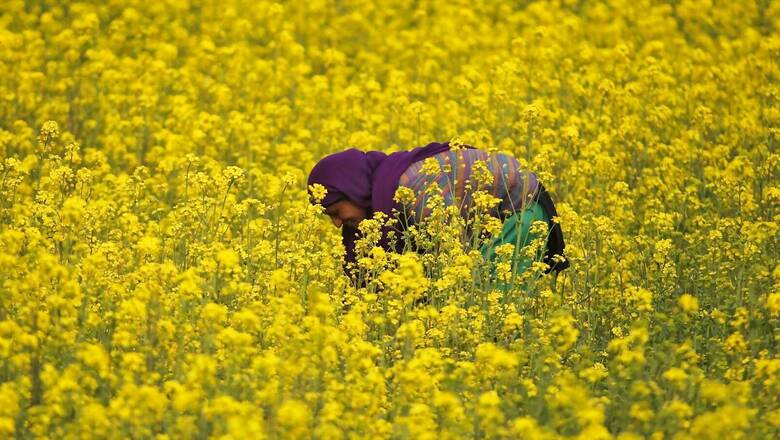
views
History has time and again shown that opportunists have benefitted whenever there has been a war between nations. Amidst the Russia-Ukraine war, imports of sunflower oil are getting affected. India imports 25 lakh tonnes of sunflower oil annually, of which 70 per cent comes from Ukraine, 20 per cent from Russia and 10 per cent from Argentina. Since our dependence on edible oil imports is around 60 per cent (of the total consumption), the government of India is weighing and exploring all possible options to source edible oil from other countries to maintain domestic supply and keep local retail prices stable. However, the problem has got compounded as import prices of palm oil too have jumped by quite a margin, otherwise a rare phenomenon.
The import price of crude palm oil is around Rs 1.45 lakh per tonne whereas crude sunflower oil is at Rs 1.46 lakh per tonne. In January, the import price of crude palm oil was Rs 1.11 lakh per tonne and the price of crude sunflower oil was Rs 1.15 lakh per tonne. When the costs for processing, packaging and transportation as well as the dealer and retailer margins are added, these edible oil retail prices reach Rs 175-180 per litre. These prices may increase further if the war between Russia and Ukraine continues.
Curbs on exports imposed by Indonesia, the largest producer of palm oil, are being also blamed for this price rise. It is high time for India to make a long-term road map for a better crop price guarantee to promote oilseed farming. This can take the country closer to self-reliance in edible oils and save the burden on foreign exchange reserves arising out of the import of edible oil as well as provide a means for an extra income of more than Rs 1 lakh crore per annum for the farmers in the country.
The government can turn this crisis triggered by the war into an opportunity for the farmers of India by taking decisions necessary to help India attain self-reliance in edible oils. It should prepare a purchase guarantee scheme at minimum support price (MSP) for farmers producing mustard, soya bean, groundnut and sunflower. This can be started with groundnut and soya bean in the coming Kharif season.
MSP System Has Failed to Deliver
For instance, in the current Rabi season, farmers of Punjab have increased the mustard acreage to 44,000 hectares from 32,000 hectares in 2020-21, in the hope of better prices. The new crop of mustard has started arriving in some markets and the prices are running close to Rs 6,500 per quintal, which is substantially higher than the MSP of Rs 5,050 per quintal fixed for the current season. If farmers’ hope for better prices is encouraged, the results can be better. To increase the productivity of mustard, it is necessary to ensure that high yielding new varieties like ‘Canola Sarson’ are sufficiently available, which would help farmers in Punjab to embark upon the much-needed diversification path by breaking the wheat-paddy crop cycle.
In Punjab of 1974-75, the mustard crop had 1.80 lakh hectares which came down to 1.01 lakh hectares by 1995-96. In 2000-01, this area under cultivation further declined to 55,000 hectares and since then it has been a gradual fall. In the Kharif season, the groundnut area increased from 2,000 hectares in 2020-21 to 2,500 hectares this year, Sesamum area increased from 2,500 hectares in 2020-21 to 3,000 this year. For sunflower, the crop cultivation area was 5,000 hectares against 2,400 hectares last year. In 1995-96, the total area under sesamum, groundnut and sunflower in Punjab was 1.03 lakh hectares.
In Punjab of 1974-75, the mustard crop had 1.80 lakh hectares which came down to 1.01 lakh hectares by 1995-96. In 2000-01, this area under cultivation further declined to 55,000 hectares and since then it has been a gradual fall.
Across India, oilseed output has increased to 37.31 million tonnes in 2020-21 from 27.51 million tonnes in 2014-15 and the area under cultivation has also gone up to 28.82 million hectares from 25.99 million hectares during this period. However, this is still inadequate to reduce India’s annual edible oil import bill. Further, the MSP system for oilseeds has failed due to low procurement by government agencies. Just like the procurement of pulses on MSP has increased, the government must also ensure procurement of oilseeds to encourage farmers to take up cultivation of oilseeds.
ALSO READ | India Needs a Millet Revolution. A Public-Private Partnership Can Set it in Motion
Replicate the Success of Pulses
India’s success story of achieving self-sufficiency in pulses can be replicated in the cultivation of oilseeds. India requires 30 million tonnes of pulses every year, of this only four million tonnes are imported to meet domestic demands. The government saves an estimated Rs 15,000 crore annually by reducing the dependence on import for pulses. The production of pulses has gone up from 14 million tonnes to 24 million tonnes between 2014 and 2021.
The government will have to make a concrete strategy. It needs to set a target to increase oilseed production for at least the next 2-3 years. It should, therefore, try to increase the groundnut and soya bean acreage for the next Kharif season, and for this, a clear message should be sent to the farmers that MSP will be ensured for their crop. Besides, if necessary, a scheme for providing bonuses may also be implemented. Such a strategy has had a positive impact on production of pulses.
In India, the annual consumption of edible oil is around 230 lakh tonnes; of this, India produces 93.18 lakh tonnes. The annual import stands at around 130 lakh tonnes — this can very well give an idea of the huge possibility of an increase in edible oil production in the country.
In India, the annual consumption of edible oil is around 230 lakh tonnes; of this, India produces 93.18 lakh tonnes (based on 2020-21 figures). This number may increase to some extent in the current year as a better production of oilseeds, especially mustard, is expected. The annual import stands at around 130 lakh tonnes — this can very well give an idea of the huge possibility of an increase in edible oil production in the country.
Consumption trends indicate that the present edible oil annual consumption of 230 lakh tonnes may exceed 250 lakh tonnes in the next two years. Given this scenario, if the government starts focusing on oilseed production from now, the dependence on imports will reduce by two-thirds. Import dependence cannot be eliminated in the near future, but if the government works with a better plan, it will benefit both farmers and consumers. State-wise oilseed crop planning and remunerative prices to the farmers can be the mantra to make India self-reliant in edible oil.
The author is Vice Chairman, Punjab State Planning Board and Chairman, ASSOCHAM Northern Region Development Council. The views expressed in this article are those of the author and do not represent the stand of this publication.
Read all the Latest Opinion News and Breaking News here


















Comments
0 comment